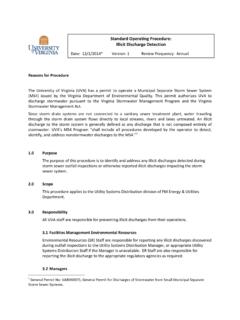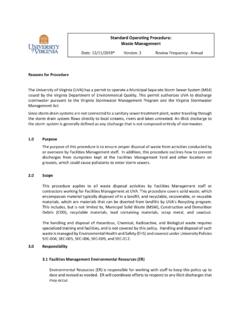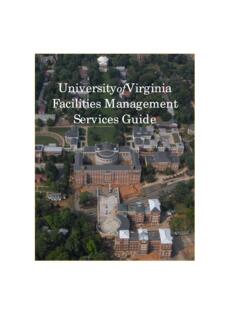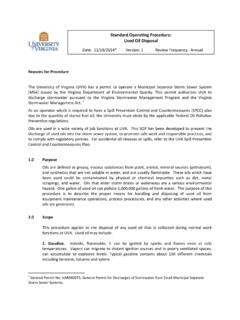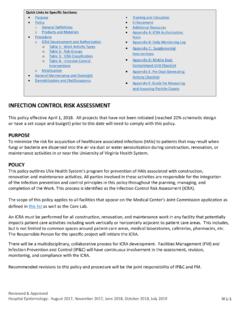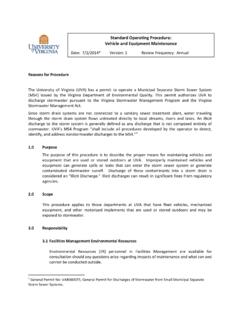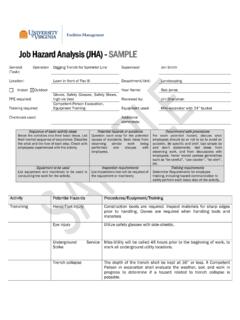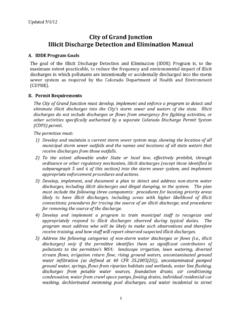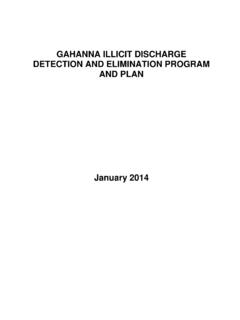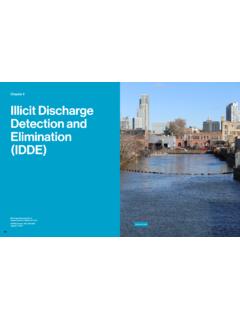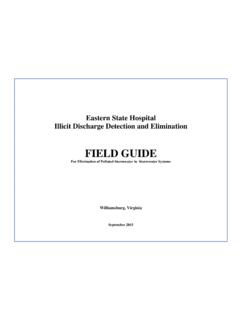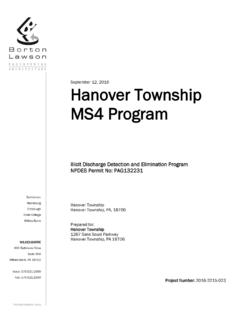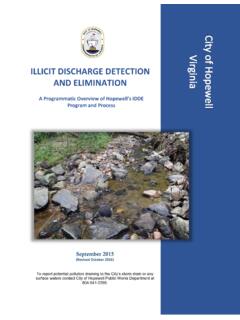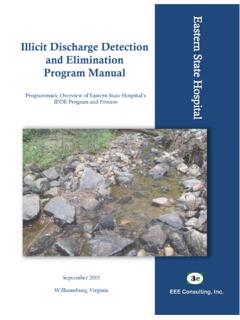Transcription of Standard Operating Procedure: Illicit Discharge Detection
1 Reasons for Procedure The University of Virginia (UVA) has a permit to operate a Municipal Separate Storm Sewer System (MS4) issued by the Virginia Department of Environmental Quality. This permit authorizes UVA to Discharge stormwater pursuant to the Virginia Stormwater Management Program and the Virginia Stormwater Management Act. Since storm drain systems are not connected to a sanitary sewer treatment plant, water traveling through the storm drain system flows directly to local streams, rivers and lakes untreated. An Illicit Discharge to the storm system is generally defined as any Discharge that is not composed entirely of stormwater. UVA s MS4 Program shall include all procedures developed by the operator to detect, identify, and address nonstormwater discharges to the MS4.
2 1 Purpose The purpose of this procedure is to identify and address any Illicit discharges detected during storm sewer outfall inspections or otherwise reported Illicit discharges impacting the storm sewer system. Scope This procedure applies to the Utility Systems Distribution division of FM Energy & Utilities Department. Responsibility All UVA staff are responsible for preventing Illicit discharges from their operations. Environmental Resources Staff Environmental Resources (ER) Staff are responsible for reporting any Illicit discharges discovered during outfall inspections to the Utility Systems Distribution Manager, or appropriate Utility Systems Distribution Staff if the Manager is unavailable. ER Staff are also responsible for reporting the Illicit Discharge to the appropriate regulatory agencies as required and conducting follow up efforts to prevent the re-occurrence of the Illicit Discharge where possible.
3 ER shall have oversight of all cleanup and remediation efforts. 1 General Permit No: VAR040073, General Permit for Discharges of Stormwater from Small Municipal Separate Storm Sewer Systems. Standard Operating Procedure: Illicit Discharge Detection Date: 8/16/2018* Version: 3 Review Frequency: Annual SOP Illicit Discharge Detection Page 2 Utility Systems Distribution Manager The Utility Systems Distribution Manager is responsible for ensuring that employees are properly informed of and trained on how to prevent Illicit discharges from their operations and understand how to trace an Illicit Discharge upon discovery. In the event an Illicit Discharge is discovered, the Utility Systems Distribution Manger must consult with ER Staff prior to taking action in order to ensure remediation efforts will not cause additional harm to state waters.
4 The Utility Systems Distribution Manager may take actions to stop or contain the release without consulting ER if the release is ongoing. Managers and supervisors are responsible for ensuring training is conducted with the most recent version of the SOP. Personnel Performing the Job Utility Systems Distribution Staff are responsible for understanding and following these procedures upon receipt of proper training. Utilities System Distribution Staff should consult with ER staff and/or the Utility Systems Distribution Manager prior to taking action to resolve any impacts from the release. Utility Systems Distribution Staff may take actions to stop or contain the Illicit Discharge without consulting ER if the release is ongoing. Procedures Initial Actions and Notifications Upon discovery of an Illicit Discharge , efforts shall be immediately undertaken to stop or contain the Discharge if possible.
5 The Utility Systems Distribution Manager will be notified of any Illicit Discharge detected during a storm sewer outfall inspection or otherwise identified as the responsibility of the Utility Systems Distribution team to address. A complete description of the Discharge and as much information as possible will be provided. Any time the Utility Systems Distribution Manager or Staff are notified of an Illicit Discharge by staff other than ER staff, ER should be notified of the Illicit Discharge . ER staff should immediately follow up on the Illicit Discharge report. Depending on the nature of the Discharge , ER staff will immediately notify DEQ of the incident, but in no case later than within 24 hours. Information on current DEQ reporting protocols can be found in section of this SOP.
6 If UVA is not the source of the Illicit Discharge , ER staff should forward information on the Illicit Discharge to Albemarle County or the City of Charlottesville as applicable. Discharge Identified If the contaminant is identified as a sanitary sewer overflow, the SSO Response SOP will be followed. Petroleum spills are to be cleaned up in accordance with the University s SPCC Plan. SOP Illicit Discharge Detection Page 3 If the contaminant is identified as hazardous, immediately call the fire department for assistance in clean-up. If the source of the Discharge is identified as being caused by an uncontrolled activity such as improper trench dewatering, wash water, or improper disposal of liquids, the staff responsible for the Illicit Discharge should be immediately notified to cease operations.
7 Their supervisor should be contacted and a verbal explanation of proper protocol should be provided to appropriate staff as soon as possible. If the source of the Discharge is determined to be a leaking piece of equipment, vehicle, or dumpster, the leak should be contained and the leaking item shall be removed from service until it can be repaired. In the case of leaking dumpsters, UVA Recycling or the site contractor should be contacted to request a properly sealed dumpster. If a contractor is causing the Illicit Discharge on UVa property, the UVa staff responsible for contractor oversight should also be contacted. The Illicit Discharge should be stopped or contained and brought to the contractor s attention and the contractor should be made aware of appropriate means for conducting activities on UVA property.
8 Discharge Not Immediately Identified If the nature and source of the Discharge is not immediately obvious, use a variety of strategies to test the Discharge and locate the source of contamination. Contact construction project managers, zone maintenance staff, and supervisors responsible for industrial activities within the drainage area to determine if they are able to help identify or isolate the source. Use GIS software to strategically check manholes in the upstream tributary storm sewer system for contamination. Visual observations should be used to look for presence of flow, colors, odors, floatable materials, or deposits or stains. The GIS map can then be used to trace the path of manholes back to the potential source. Manholes closest to the outfall should be investigated first, with staff progressively moving up the sewer network and inspecting manholes until it can be determined either where the source is coming in or between which two manholes the source is coming in.
9 Dye testing can be conducted to determine if there are any improper connections between the sanitary sewer and the storm sewer. Dye tests can also provide valuable information as to whether stormwater systems are malfunctioning, and can confirm water flow direction. Camera equipment can also be used to locate the source of contamination, by exploring the storm sewer system and looking for pollution between manholes. Smoke testing can be used to identify cross-connections with the sanitary sewer or other underground sources caused by damage to the storm drain. Smoke SOP Illicit Discharge Detection Page 4 testing should be used as a last resort, as others within the area should be notified in advance of the smoke testing so as not to cause alarm. Utilities or Zone staff should be immediately notified in the event that a cross connection is discovered in order to mitigate the cross connection as soon as possible.
10 If the above efforts do not identify the source of the Illicit Discharge , ER staff should revisit the site approximately 24 hours from the time the Discharge was initially reported to see if the Discharge reoccurs. If there is no Discharge observed during the follow up visit, the Discharge should be considered a one-time event. The event should be documented in detail in case a similar event happens in the future and a pattern can be identified. Remediation Efforts Efforts to clean up the Illicit Discharge or remediate impacts caused by the Illicit Discharge shall only be undertaken after consultation with ER staff. ER staff, in consultation with DEQ where applicable, shall make the final decision on appropriate steps to clean up or remediate impacts caused by the Discharge .
